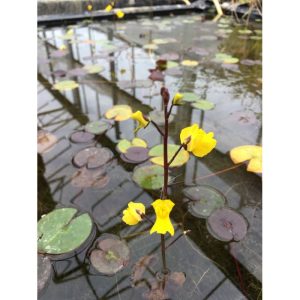Home " Oxygen plants " Yellow Plump
Yellow plump (Nuphar lutea) is an impressive floating plant with large yellow flowers and sturdy leaves that cover the water surface. This plant is naturally common in Dutch lakes, wide ditches and estuaries. Its striking blooms and robust growth make it a valuable oxygen plant for large and deep ponds. Order easily via our partner: Ordering yellow plump at Pond Master
Yellow plump is a representative of the Nymphaeaceae family and develops through rhizomes, with leaves that partly float on the water and partly remain underwater.
The species develops best in slow-flowing or stagnant water with soft, nutrient-rich soil. Typical sites are low moorlands, river banks, ponds and wide canals. The plant is completely indigenous and occurs almost everywhere in the Netherlands - with the exception of Zeeland, the Wadden Islands and parts of southern Limburg.
In spring, the first floating leaves appear, followed by the yellow flowers that rise above the water. The distinctive flowers emit a characteristic scent that serves to attract insects that help in reproduction. Underwater, transparent leaves provide additional oxygen production.
The rhizome grows horizontally across the soil and stores nutrients for several seasons. New leaves and flower stalks grow up from this rhizome every year. In autumn, the above-ground parts die off, after which the plant goes into dormancy.
Yellow plump is ideal for large, deep ponds that require oxygen plants that also provide shade and cover for fish. By tempering the light at the water surface, the large leaves help control algae growth. In addition, the flowers provide visual appeal in summer.
What is the ideal depth for Yellow Plump?
The ideal yellow plump depth lies between the 50 and 300 cm. In this depth zone, both floating leaves and flowers can develop well and the rhizome remains protected in the muddy pond bottom.
It is important to give Yellow Plump plenty of space. In small ponds, this plant can quickly become too dominant. In larger ponds, it grows into an impressive oxygen producer and biodiversity enhancer.
Note: Yellow plump can expand quickly and take up a lot of space. If necessary, use a pond basket to limit growth.
Good combinations:
For a pond of 1000 to 2000 litres, one plant is usually sufficient. In larger ponds, 2 to 3 plants are suitable. Calculate here how many oxygen plants you need in the pond.
Yellow plump is perennial and can grow for years via the rhizome, provided the pond is deep enough and does not become completely overgrown.
Yes, the plant overwinters in a dormant state via the rhizome under water.
In large ponds, hardly any maintenance is required. In case of excessive growth, some leaves or flowers can be removed in autumn.
Not necessary in a natural pond. The plant extracts nutrients from the water and soil.

Yellow Plump can be ordered through our sales partner Vijvermeester.nl.
Zuurstofplanten.net is a website of Dutch Water Tech. Specialist in water treatment for municipalities and water boards. Would you like to know more? Visit dutchwatertech.co.uk for more information on our projects.
Dutch Water Tech BV
Gateway 1
4613 BW Bergen op Zoom
You can buy oxygen plants, bank plants and other pond products through our partner Vijvermeester.nl.
© 2025 Dutch Water Tech. All rights reserved.